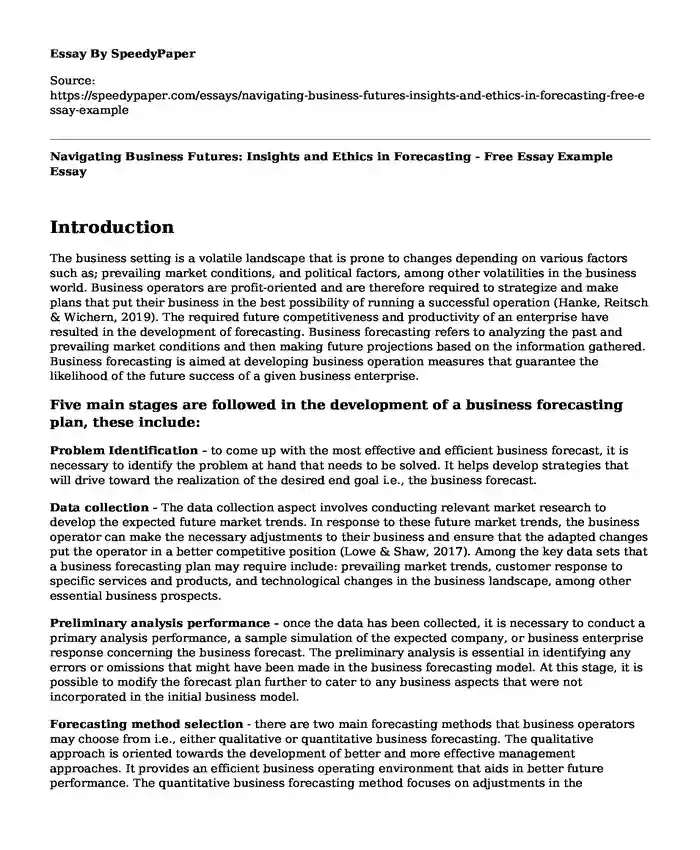Introduction
The business setting is a volatile landscape that is prone to changes depending on various factors such as; prevailing market conditions, and political factors, among other volatilities in the business world. Business operators are profit-oriented and are therefore required to strategize and make plans that put their business in the best possibility of running a successful operation (Hanke, Reitsch & Wichern, 2019). The required future competitiveness and productivity of an enterprise have resulted in the development of forecasting. Business forecasting refers to analyzing the past and prevailing market conditions and then making future projections based on the information gathered. Business forecasting is aimed at developing business operation measures that guarantee the likelihood of the future success of a given business enterprise.
Five main stages are followed in the development of a business forecasting plan, these include:
Problem Identification - to come up with the most effective and efficient business forecast, it is necessary to identify the problem at hand that needs to be solved. It helps develop strategies that will drive toward the realization of the desired end goal i.e., the business forecast.
Data collection - The data collection aspect involves conducting relevant market research to develop the expected future market trends. In response to these future market trends, the business operator can make the necessary adjustments to their business and ensure that the adapted changes put the operator in a better competitive position (Lowe & Shaw, 2017). Among the key data sets that a business forecasting plan may require include: prevailing market trends, customer response to specific services and products, and technological changes in the business landscape, among other essential business prospects.
Preliminary analysis performance - once the data has been collected, it is necessary to conduct a primary analysis performance, a sample simulation of the expected company, or business enterprise response concerning the business forecast. The preliminary analysis is essential in identifying any errors or omissions that might have been made in the business forecasting model. At this stage, it is possible to modify the forecast plan further to cater to any business aspects that were not incorporated in the initial business model.
Forecasting method selection - there are two main forecasting methods that business operators may choose from i.e., either qualitative or quantitative business forecasting. The qualitative approach is oriented towards the development of better and more effective management approaches. It provides an efficient business operating environment that aids in better future performance. The quantitative business forecasting method focuses on adjustments in the production amounts of a particular commodity and how adjusting the production volumes could help the company perform better.
Data analysis - Data analysis entails the systematic review of all the numerical and statistical information related to the selected business forecasting model. Through the data analysis process, it is possible to develop more accurate future projections for a company’s activities.
Model performance verification - once a business forecasting method has been selected, it is necessary to conduct a verification process to ensure that the chosen forecasting model is the most appropriate for the business operations in question.
Importance of Business Analysis and Forecasting
Business analysis and forecasting serve a vital role in determining the likelihood of the future success of a given business enterprise (Lowe & Shaw, 2017). Considering the volatility of the business landscape environment, business forecasting helps adjust and amend a particular business perspective that puts a business enterprise in a better position. Business analysis and forecasting can predict losses before they happen, thereby promptly coming up with aggressive measures. Analysis significantly helps to save the company immeasurable losses, which could have been incurred in the absence of a forecasting model.
The forecasting aspect also helps business owners identify which products the customers are more willing or likely to purchase in the future and make the necessary adjustments to ensure that they can meet the customer demands.
Ethical and Legal Concerns Associated with Business Forecasting
Business forecasting has been shrouded by ethical concerns where unscrupulous business operators have taken advantage of the business forecasts to exploit prospective investors. This is because most investors make their investments based on the likelihood of future success. Some operators have taken advantage of some incidences, even with forecasted failures, to rob unsuspecting clients. From a legal perspective, it is illegal to make projections that are not fully verified available to the public. This is because any such intention without a precise analysis and implementation approach is a fraudulent business practice. Therefore, it is necessary to come up with ethical and legal systems that will be used in the governance of business forecasting methods. This will help avoid any unnecessary altercations that often arise due to unethical and illegal business forecasting methods.
References
Hanke, J. E., Reitsch, A. G., & Wichern, D. W. (2019). Business forecasting (Vol. 9). New Jersey: Prentice-Hall.
Lowe, E. A., & Shaw, R. W. (2017). The accuracy of short-term business forecasting: an analysis of a firm's sales budgeting. The Journal of Industrial Economics, 275-289.
Cite this page
Navigating Business Futures: Insights and Ethics in Forecasting - Free Essay Example. (2024, Jan 08). Retrieved from https://speedypaper.com/essays/navigating-business-futures-insights-and-ethics-in-forecasting-free-essay-example
Request Removal
If you are the original author of this essay and no longer wish to have it published on the SpeedyPaper website, please click below to request its removal:
- Essay Example on the Aviation Industry's Four Pillar Concept
- Reasons for Doing Business Overseas, Essay Sample
- Free Essay with the SWOT Analysis and the STP Analysis of Amazon Go
- Business Plan Sample for Northwest Oregon Logging Company
- Essay Sample on Artificial Intelligence
- Free Essay - Funding Types and Option
- Successful Diet Pill Brand Symbolizes Company's Success - Essay Sample
Popular categories





